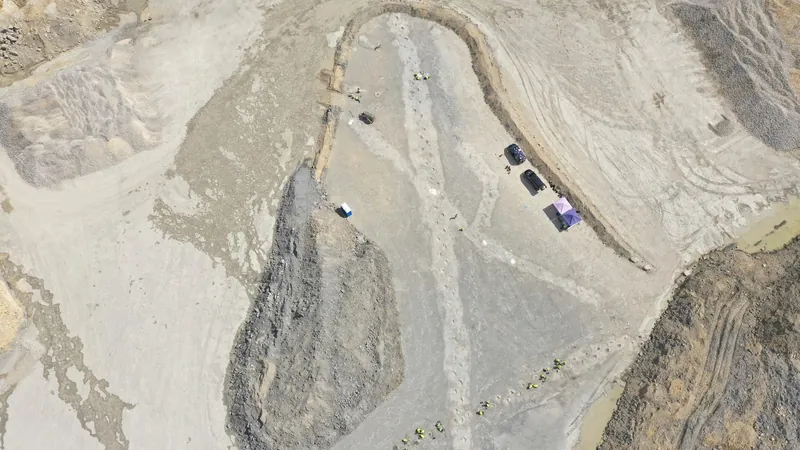
Unearthed 'Dinosaur Highway': 166 Million-Year-Old Tracks Found in England Spark Excitement
2025-01-02
Author: Wei
Unearthed 'Dinosaur Highway': 166 Million-Year-Old Tracks Found in England Spark Excitement
In a groundbreaking discovery, researchers have unveiled a remarkable "dinosaur highway" in southern England, where nearly 200 dinosaur tracks dating back 166 million years were found in a limestone quarry. The find, which occurred during a clay excavation at Dewars Farm Quarry in Oxfordshire, was initiated by a keen-eyed worker who noticed unusual formations in the ground.
This extraordinary discovery, uncovered by a team of over 100 scientists from the universities of Oxford and Birmingham, significantly adds to the existing paleontological research in the region and offers new insights into the Middle Jurassic period, which was a crucial time for dinosaur evolution.
Kirsty Edgar, a leading micropaleontology professor at the University of Birmingham, elaborated on the significance of the tracks: “These footprints provide an unprecedented glimpse into the lives of dinosaurs, revealing critical details about their movements, interactions, and the lush tropical ecosystems they thrived in.”
Among the remarkable finds are four sets of tracks attributed to massive long-necked sauropods, likely belonging to the species Cetiosaurus, which could reach lengths of nearly 60 feet (18 meters). Additionally, the discovery includes prints from the Megalosaurus, a formidable predator that measured about 30 feet (9 meters) long. The Megalosaurus is famously recognized as the first dinosaur ever to receive a scientific name, identified over 200 years ago.
Intriguingly, some tracks overlap, suggesting potential interactions between the herbivorous sauropods and the carnivorous Megalosaurus, raising fascinating questions about the dynamics of prehistoric ecosystems.
Emma Nicholls, a vertebrate paleontologist at the Oxford University Museum of Natural History, highlighted the significance of this find: “Scientists have been studying Megalosaurus longer than any other dinosaur. Yet, evidence like this shows that new discoveries are still waiting to be made.”
This discovery is especially notable because, nearly thirty years ago, another group found 40 dinosaur footprints in the same general area, which were considered among the most significant track sites globally. However, that earlier site is now mostly inaccessible, and photographic documentation was limited due to the era's lack of digital technology.
In contrast, the recent undertaking this summer resulted in the capture of over 20,000 digital images and 3D modeling of the tracks, utilizing drone technology to ensure thorough documentation. This meticulous record-keeping will be invaluable for future studies, painting a clearer picture of dinosaur behavior, their physical dimensions, and mobility.
“The preservation of these footprints is extraordinarily detailed; we can even see how the ground was deformed as the dinosaurs moved through it,” explained Duncan Murdock, an earth scientist associated with the Oxford museum. He added that alongside other fossils such as burrows, shells, and plant remains, scientists are now able to reconstruct the muddy lagoon habitat that these dinosaurs inhabited.
To showcase this phenomenal find, the Oxford University Museum will host a new exhibit, and highlights of the discovery will also be featured in the upcoming episode of BBC’s “Digging for Britain.” Stay tuned for an inside look at how these majestic creatures once roamed their terrestrial domain!


 Brasil (PT)
Brasil (PT)
 Canada (EN)
Canada (EN)
 Chile (ES)
Chile (ES)
 Česko (CS)
Česko (CS)
 대한민국 (KO)
대한민국 (KO)
 España (ES)
España (ES)
 France (FR)
France (FR)
 Hong Kong (EN)
Hong Kong (EN)
 Italia (IT)
Italia (IT)
 日本 (JA)
日本 (JA)
 Magyarország (HU)
Magyarország (HU)
 Norge (NO)
Norge (NO)
 Polska (PL)
Polska (PL)
 Schweiz (DE)
Schweiz (DE)
 Singapore (EN)
Singapore (EN)
 Sverige (SV)
Sverige (SV)
 Suomi (FI)
Suomi (FI)
 Türkiye (TR)
Türkiye (TR)
 الإمارات العربية المتحدة (AR)
الإمارات العربية المتحدة (AR)